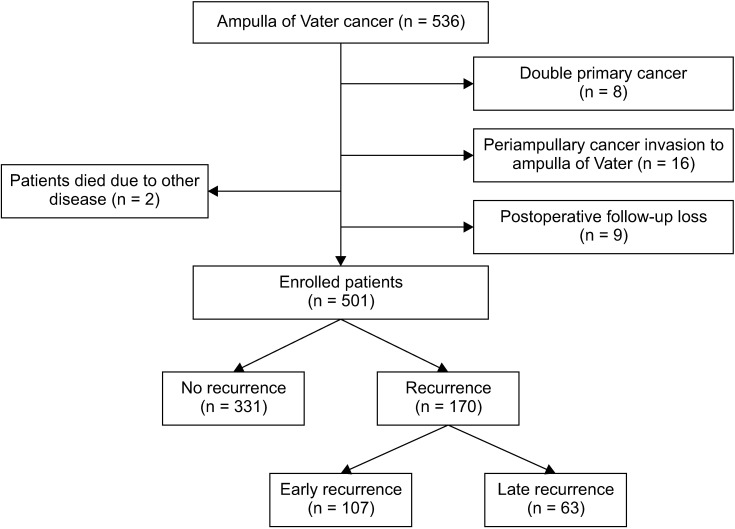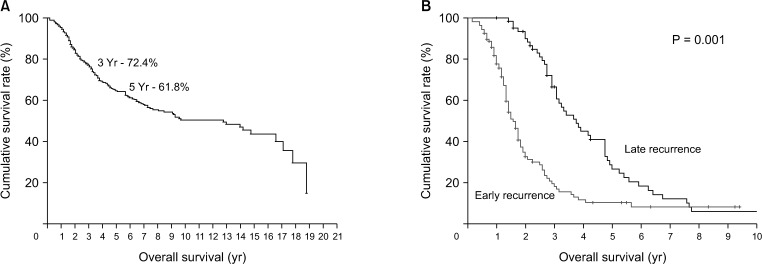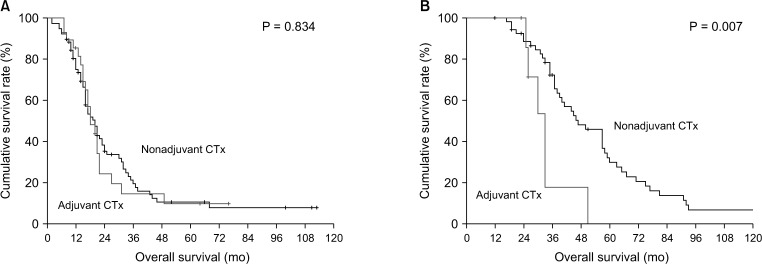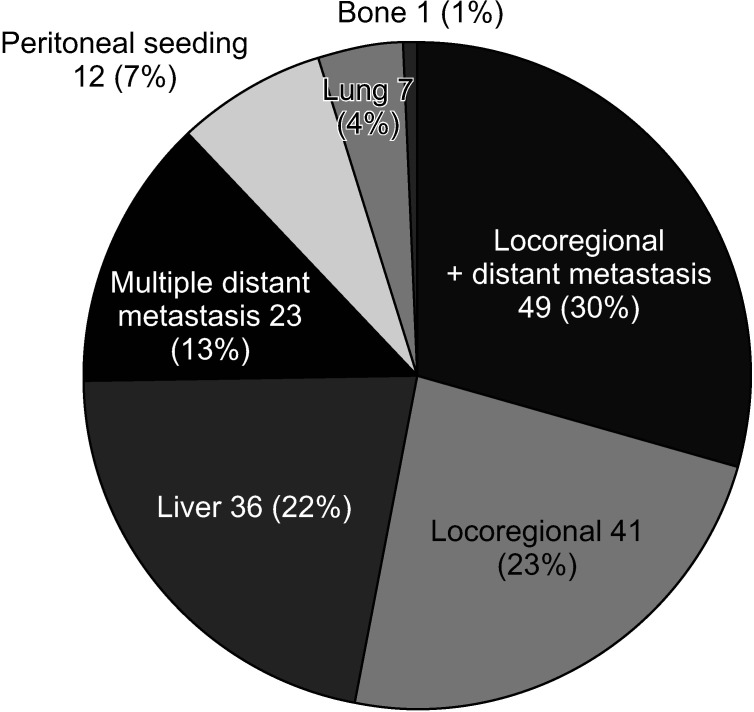Ann Surg Treat Res.
2020 Nov;99(5):259-267. 10.4174/astr.2020.99.5.259.
Predictors of early recurrence following a curative resection in patients with a carcinoma of the ampulla of Vater
- Affiliations
-
- 1Department of Surgery, Gangneung Asan Hospital, University of Ulsan College of Medicine, Gangneung, Korea
- 2Division of Hepatobiliary and Pancreatic Surgery, Department of Surgery, Asan Medical Center, University of Ulsan College of Medicine, Seoul, Korea
- KMID: 2508322
- DOI: http://doi.org/10.4174/astr.2020.99.5.259
Abstract
- Purpose
Ampulla of Vater (AoV) carcinoma has a relatively good prognosis. The 5-year recurrence rate for AoV is still around 40%–50% however, and most recurrences occur in the early period. The aim of this study was to identify predictors of an early recurrence in AoV patients following a curative resection.
Methods
The clinicopathological data for 501 consecutive patients that underwent a resection for AoV in our institute between January 2000 and December 2015 were retrospectively reviewed. The characteristics of any recurrences and early recurrence patients were analyzed accordingly. Early recurrence was defined as occurring within one year of resection.
Results
There were 170 diagnosed recurrences in our study population, 57.1% of whom were men, with a mean age of 60.1 years (range, 30–94 years). Almost all of the study patients underwent a pancreaticoduodenectomy, and 9% underwent minimally invasive surgery. Of the 170 recurrent cases, 107 were diagnosed with an early recurrence and had 1-, 3-, and 5-year overall survival rates of 77.7%, 18.4%, 10.5%, respectively. The factors that significantly influenced early recurrences, determined by multivariate analysis, lymphovascular invasion (LVI), lymph node ratio (LNR), and poor differentiation were found to be independent determinants of a recurrence within 1 year.
Conclusion
An early recurrence in AoV patients is ultimately lethal even though this cancer has a good prognosis. LVI, LNR, and poor differentiation are powerful predictors of an early recurrence in AoV. Hence, intensive surveillance and new therapeutic strategies should be considered for AoV patients with these predictors following a curative resection.
Figure
Reference
-
1. Bucher P, Chassot G, Durmishi Y, Ris F, Morel P. Long-term results of surgical treatment of Vater's ampulla neoplasms. Hepatogastroenterology. 2007; 54:1239–1242. PMID: 17629078.2. Park JS, Yoon DS, Kim KS, Choi JS, Lee WJ, Chi HS, et al. Factors influencing recurrence after curative resection for ampulla of Vater carcinoma. J Surg Oncol. 2007; 95:286–290. PMID: 17326125.3. Bhatia S, Miller RC, Haddock MG, Donohue JH, Krishnan S. Adjuvant therapy for ampullary carcinomas: the Mayo Clinic experience. Int J Radiat Oncol Biol Phys. 2006; 66:514–519. PMID: 16863684.4. Todoroki T, Koike N, Morishita Y, Kawamoto T, Ohkohchi N, Shoda J, et al. Patterns and predictors of failure after curative resections of carcinoma of the ampulla of Vater. Ann Surg Oncol. 2003; 10:1176–1183. PMID: 14654474.5. Beger HG, Treitschke F, Gansauge F, Harada N, Hiki N, Mattfeldt T. Tumor of the ampulla of Vater: experience with local or radical resection in 171 consecutively treated patients. Arch Surg. 1999; 134:526–532. PMID: 10323425.6. Hsu HP, Shan YS, Hsieh YH, Yang TM, Lin PW. Predictors of recurrence after pancreaticoduodenectomy in ampullary cancer: comparison between non-, early and late recurrence. J Formos Med Assoc. 2007; 106:432–443. PMID: 17588836.7. Huh JW, Kim CH, Lim SW, Kim HR, Kim YJ. Early recurrence in patients undergoing curative surgery for colorectal cancer: is it a predictor for poor overall survival? Int J Colorectal Dis. 2013; 28:1143–1149. PMID: 23503665.8. Yamamoto Y, Ikoma H, Morimura R, Konishi H, Murayama Y, Komatsu S, et al. Optimal duration of the early and late recurrence of pancreatic cancer after pancreatectomy based on the difference in the prognosis. Pancreatology. 2014; 14:524–529. PMID: 25287158.9. Cheng Z, Yang P, Qu S, Zhou J, Yang J, Yang X, et al. Risk factors and management for early and late intrahepatic recurrence of solitary hepatocellular carcinoma after curative resection. HPB (Oxford). 2015; 17:422–427. PMID: 25421805.10. Zhou J, Hsu CC, Winter JM, Pawlik TM, Laheru D, Hughes MA, et al. Adjuvant chemoradiation versus surgery alone for adenocarcinoma of the ampulla of Vater. Radiother Oncol. 2009; 92:244–248. PMID: 19541379.11. Lee JH, Whittington R, Williams NN, Berry MF, Vaughn DJ, Haller DG, et al. Outcome of pancreaticoduodenectomy and impact of adjuvant therapy for ampullary carcinomas. Int J Radiat Oncol Biol Phys. 2000; 47:945–953. PMID: 10863064.12. Krishnan S, Rana V, Evans DB, Varadhachary G, Das P, Bhatia S, et al. Role of adjuvant chemoradiation therapy in adenocarcinomas of the ampulla of vater. Int J Radiat Oncol Biol Phys. 2008; 70:735–743. PMID: 17980502.13. Kwon J, Kim BH, Kim K, Chie EK, Ha SW. Survival benefit of adjuvant chemoradiotherapy in patients with ampulla of Vater cancer: a systematic review and meta-analysis. Ann Surg. 2015; 262:47–52. PMID: 25775067.14. Talamini MA, Moesinger RC, Pitt HA, Sohn TA, Hruban RH, Lillemoe KD, et al. Adenocarcinoma of the ampulla of Vater: a 28-year experience. Ann Surg. 1997; 225:590–600. PMID: 9193186.15. Kim KJ, Choi DW, Kim WS, Kim MJ, Song SC, Heo JS, et al. Adenocarcinoma of the ampulla of Vater: predictors of survival and recurrence after curative radical resection. Korean J Hepatobiliary Pancreat Surg. 2011; 15:171–178. PMID: 26421035.16. Qiao QL, Zhao YG, Ye ML, Yang YM, Zhao JX, Huang YT, et al. Carcinoma of the ampulla of Vater: factors influencing long-term survival of 127 patients with resection. World J Surg. 2007; 31:137–146. PMID: 17171495.17. Hsu HP, Yang TM, Hsieh YH, Shan YS, Lin PW. Predictors for patterns of failure after pancreaticoduodenectomy in ampullary cancer. Ann Surg Oncol. 2007; 14:50–60. PMID: 17054003.18. Kim RD, Kundhal PS, McGilvray ID, Cattral MS, Taylor B, Langer B, et al. Predictors of failure after pancreaticoduodenectomy for ampullary carcinoma. J Am Coll Surg. 2006; 202:112–119. PMID: 16377504.19. Allema JH, Reinders ME, van Gulik TM, van Leeuwen DJ, Verbeek PC, de Wit LT, et al. Results of pancreaticoduodenectomy for ampullary carcinoma and analysis of prognostic factors for survival. Surgery. 1995; 117:247–253. PMID: 7878528.20. Choi SB, Kim WB, Song TJ, Suh SO, Kim YC, Choi SY. Surgical outcomes and prognostic factors for ampulla of Vater cancer. Scand J Surg. 2011; 100:92–98. PMID: 21737384.21. Carter JT, Grenert JP, Rubenstein L, Stewart L, Way LW. Tumors of the ampulla of vater: histopathologic classification and predictors of survival. J Am Coll Surg. 2008; 207:210–218. PMID: 18656049.22. Woo SM, Ryu JK, Lee SH, Yoo JW, Park JK, Kim YT, et al. Recurrence and prognostic factors of ampullary carcinoma after radical resection: comparison with distal extrahepatic cholangiocarcinoma. Ann Surg Oncol. 2007; 14:3195–3201. PMID: 17710498.23. Colussi O, Voron T, Pozet A, Hammel P, Sauvanet A, Bachet JB, et al. Prognostic score for recurrence after Whipple's pancreaticoduodenectomy for ampullary carcinomas; results of an AGEO retrospective multicenter cohort. Eur J Surg Oncol. 2015; 41:520–526. PMID: 25680954.24. Howe JR, Klimstra DS, Moccia RD, Conlon KC, Brennan MF. Factors predictive of survival in ampullary carcinoma. Ann Surg. 1998; 228:87–94. PMID: 9671071.25. Sakata J, Shirai Y, Wakai T, Ajioka Y, Akazawa K, Hatakeyama K. Assessment of the nodal status in ampullary carcinoma: the number of positive lymph nodes versus the lymph node ratio. World J Surg. 2011; 35:2118–2124. PMID: 21717240.26. Hurtuk MG, Hughes C, Shoup M, Aranha GV. Does lymph node ratio impact survival in resected periampullary malignancies? Am J Surg. 2009; 197:348–352. PMID: 19245913.27. Kayahara M, Nagakawa T, Ohta T, Kitagawa H, Miyazaki I. Surgical strategy for carcinoma of the papilla of Vater on the basis of lymphatic spread and mode of recurrence. Surgery. 1997; 121:611–617. PMID: 9186460.28. Lee JH, Lee KG, Ha TK, Jun YJ, Paik SS, Park HK, et al. Pattern analysis of lymph node metastasis and the prognostic importance of number of metastatic nodes in ampullary adenocarcinoma. Am Surg. 2011; 77:322–329. PMID: 21375845.29. Yeo CJ, Cameron JL, Lillemoe KD, Sohn TA, Campbell KA, Sauter PK, et al. Pancreaticoduodenectomy with or without distal gastrectomy and extended retroperitoneal lymphadenectomy for periampullary adenocarcinoma, part 2: randomized controlled trial evaluating survival, morbidity, and mortality. Ann Surg. 2002; 236:355–368. PMID: 12192322.30. Cloyd JM, Wang H, Overman M, Zhao J, Denbo J, Prakash L, et al. Influence of preoperative therapy on short- and long-term outcomes of patients with adenocarcinoma of the ampulla of Vater. Ann Surg Oncol. 2017; 24:2031–2039. PMID: 28124275.
- Full Text Links
- Actions
-
Cited
- CITED
-
- Close
- Share
- Similar articles
-
- A Case of Early Carcinoma of the Ampulla of Vater Combined with Adenoma of Colon
- Correlation of Ki-67, nm23-H1 and the VEGF Expression with the Clinicopathological Variables for Distant Recurrence after Curative Surgery for Carcinoma of the Ampulla of Vater
- A Case of Hepatectomy for Liver Metastasis after Pancreatoduodenectomy for Carcinoma of Ampulla of Vater
- Recurrence Patterns and Risk Factors of Early Recurrence after Curative Resection of Ampulla of Vater Cancer
- Adenocarcinoma of the ampulla of Vater: predictors of survival and recurrence after curative radical resection





